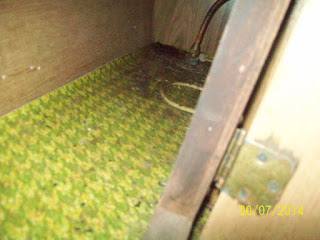The 16SC, with all its original everything, became difficult to plan on doing anything that did not retain its originality. The camper had been quite well preserved, and unmolested. It came with nearly all of its original equipment. It really appealed to the "purist" in me.
In the time period that this camper was built, Shasta was using materials that reflected the styles and tastes of the time. Case in point, the dark wall paneling. I remember that being the "vogue" of the day, the style that went with the earliest of the '70-s. The harvest golds and the greens and the yellows and the avocados and the earthtones, and that dark-assed wood-grain paneling. Now personally, I think it makes the small space feel like a cave...small and cramped and close. But the more it cleaned up and shined, the more it grew on me.

That was only a part of the whole picture, too. The green and yellow in
the linoleum came to life as it cleaned and polished as well. A couple
of added touches was all it took to brighten it up to a point of
likable. I decided to paint over all the unfinished wood, in the seat
benches and the bed top, with a bright white enamel paint. That would
seal the wood against smelling from being closed up all that time, as
well as protecting it from any moisture or further staining. It also
lightened up the overall feel of the space. Add to that the bright
lime-candy green trim around the doors and drawers, and it started to
feel almost "modern".

Part of the cleanup included removing the appliances and they were tested while they were outside the camper. I figured it would be better if a propane burner failed outdoors rather than taking out the whole unit.....
With a good amount of cleaning the stove looked like new, and then it acted that way too. Even the oven lit and burned properly. The heater and refrigerator both cleaned up and worked as well. This was a great start toward making the systems work as they should.
The water system waited until it warmed considerably in the Spring before any testing
was done. I sure did not need a freeze to ruin something that might not
already need repair.

As the fall slid into the winter months, one of the last chores that
got done was rebuilding the door. The bottom of it was rotted away and
the door would not close at all. It was held shut most of the time with
a tie strap. That is not acceptable going into the season when all the
mice in the neighborhood are trying to move in.
I re-framed it using materials as close to the size of the original
as possible. Styrofoam insulation board was added. I also reinforced
the lower corner to hold up better, to help keep that corner lifted from
the door frame.
Quite possibly the luckiest part was hanging the door back on the
hinge. Somehow it came out perfect. The latch was all cleaned and the
lock cylinder refitted, so it closed and latched, and now locked, just
as it should. This was a great accomplishment for the last repair
before winter.
Once it became clear that we were going to have winter, as unusual as that may seem for upstate New York in December, the only choice was to leave the camper under the carport. The broken roof vents would need to be covered to keep the wintertime from destroying the fairly well-kept interior. So, the car and truck moved out from their shelter, and the camper moved in.
Come Spring and warmer weather, more and more detailing got done. The water system proved to be challenging. The onboard pump did not work, and the pipe joints leaked everywhere. Plumbing 101 ("hot's on the left, sh*t runs downhill, payday is Friday") fixed most of the problems.
Slowly over the summer, the roof vents were all replaced and sealed.

Wiring for the tail and running lights was all checked,
and new marker lights were installed.
All the corners and J-rails were taken apart, and new putty tape installed.
All of the windows, door frames, and cargo hatches were removed, cleaned, polished, and replaced with new putty tape as well.
As one should expect, a 40-some year-old camper hides some surprises that come naturally with water leaks and age. This one is not
any exception. The exceptional part is that it was not worse than it was...mostly because it was sheltered for so much of its life.
All of the framework was checked for rot, and this corner below the refrigerator vent (which had been missing) was the only place that required any significant work. New insulation board was added in the front wall as well.
One of the biggest disappointments was finding the black-water holding
tank broken, rendering the toilet facilities unusable. It was decided
for now to remove the toilet and use the porta-potty. This will be one
of the experiments conducted. It may work out to be the best option,
and if not, we have the parts to put it all back together again.
All in all it is turning out pretty well. We still have a bunch of work to do yet though. It is amazing how much has gone into it already, after needing, relatively speaking, so little to start with. All the effort will be worth it. Sure looks a lot prettier now!
















































